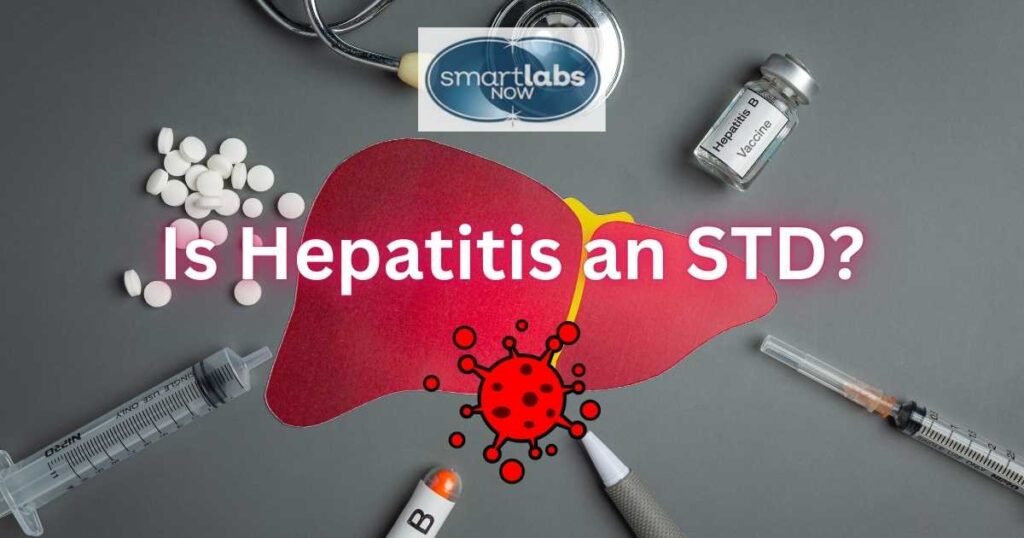
Hepatitis is a liver infection caused by different viruses, but not all forms of hepatitis are sexually transmitted. Hepatitis B, in particular, can be transmitted through sexual contact (warranting the STI classification), making it important to understand the types of tests, symptoms, modes of transmission, and prevention strategies associated with the disease.
This guide focuses on hepatitis B and C while covering other forms of hepatitis to help potential test-takers and individuals concerned about their health.
If you would like to skip directly to schedule your test, register here:

Hepatitis B (HBV) is a serious liver infection that can become chronic, leading to long-term complications such as liver cirrhosis or liver cancer. Doctors use specific blood tests to diagnose HBV that identify viral markers and immunity status.
This test detects antibodies to the hepatitis B core antigen, indicating whether a person has been infected with HBV at some point. A positive result suggests a past or ongoing infection.
The Anti-HBs test checks for antibodies produced in response to the hepatitis B surface antigen. A positive result means the person is immune to hepatitis B due to vaccination or recovery from a past infection.
The surface antigen test identifies the presence of the hepatitis B virus in the blood. A positive result indicates an active infection, either acute or chronic, and the person is contagious.
Hepatitis B can be acute (short-term) or chronic (long-term). Blood tests help determine the stage of infection. Acute infections may resolve on their own, while chronic hepatitis B often requires ongoing management to prevent liver damage.
HBV is transmitted through blood and bodily fluids. Key risk groups include men who have sex with men (MSM), sex partners of people with hepatitis B, sexually active individuals, and those who share needles or sharp objects. Understanding your immunity status through testing is crucial, especially if you fall into these risk categories.
A hepatitis panel test is a comprehensive tool for understanding your infection status and ensuring timely intervention, particularly if you are at risk or show symptoms of hepatitis.

Hepatitis B can be a silent infection, with symptoms often appearing months after exposure. However, some common signs of an acute infection include:
Feeling unusually tired without reason.
A mild fever is sometimes present, especially during the early stages.
In some cases, individuals may experience a high fever, signaling infection.
Yellowing of the skin and eyes due to liver dysfunction.
Achy joints can occur during the infection’s onset.
Discomfort or pain in the abdomen is common, reflecting liver inflammation.
Many of these symptoms overlap with other illnesses, so getting tested is the only way to know if you have hepatitis B.

Hepatitis B is considered a sexually transmitted disease (STD) because it can spread through sexual contact, although this is not the only mode of transmission.
The virus can be transmitted through vaginal, anal, and oral sex, especially when bodily fluids like semen or vaginal fluids are exchanged. People with multiple sexual partners are at higher risk, especially if they are unvaccinated.
Hepatitis B is also spread through blood, often from sharing needles or through blood transfusions where adequate screening is lacking.
Fortunately, there is a highly effective vaccine for hepatitis B, which is recommended for people at risk, including those with multiple sexual partners and healthcare workers.
Hepatitis B can result in a serious liver infection, particularly in unvaccinated individuals. Unprotected sex, sharing needles, or exposure to infected blood all increase the risk of contracting the virus.

Preventing hepatitis B involves multiple strategies, many of which are highly effective when used correctly:
The Centers for Disease Control and Prevention (CDC) and the Hepatitis B Foundation recommend that all infants, unvaccinated children, and adults in high-risk groups receive the hepatitis B vaccine. It offers long-term protection against HBV infection and is particularly important for sexually active individuals.
Using condoms during vaginal or anal sex and dental dams during oral sex significantly reduces the risk of transmitting hepatitis B and other STDs. Safer sex practices like these are essential for those who are unvaccinated or unsure of their partner’s status.
Those who inject drugs should never share needles, as this is a major route of transmission for hepatitis B.
If you are sexually active or belong to a risk group, regular testing helps catch infections early and protects your health.
By following these guidelines, you can significantly reduce your risk of contracting hepatitis B and protect your liver from long-term damage.

Though hepatitis C (HCV) is less commonly considered an STD, it can still be transmitted through sexual contact in certain circumstances. It is primarily spread through direct contact with infected blood.
Improved blood screening practices have reduced the risk of hepatitis C transmission through blood transfusions and organ transplants.
Sharing needles or syringes remains one of the most common ways hepatitis C is transmitted.
In some cases, hepatitis C can be spread in medical settings if proper sterilization techniques are not followed.
Unsterilized tattoo or piercing needles can transmit the virus.
While sexual transmission of hepatitis C is less common, it can occur, especially in individuals who have multiple sexual partners or pre-existing STDs.
There are reported cases of Hepatitis C infection transmitted to growing infants from their mothers.
Hepatitis C is often a silent infection, but blood tests can detect the virus and help prevent liver damage if diagnosed early.

While hepatitis B and C are the most discussed in terms of STDs, other types of hepatitis also exist, each with unique transmission modes and risks.
Spread primarily through contaminated food or water, hepatitis A is not considered an STD, though it can sometimes be spread through oral-anal contact during sex. Vaccination can prevent hepatitis A, and symptoms typically resolve on their own.
Hepatitis D co-infects with hepatitis B, while hepatitis E is primarily transmitted through water. Neither is typically associated with sexual transmission but can still cause liver disease.
Chronic hepatitis infections, particularly hepatitis B and C, can lead to serious liver diseases, such as cirrhosis and liver cancer. Prevention and early diagnosis are crucial in managing these conditions.
Understanding the broader spectrum of hepatitis infections helps highlight the importance of preventive measures, regular testing, and vaccination, especially for those at risk.

One common question is whether individuals who had hepatitis A in the past can donate blood. The answer is yes. Unlike hepatitis B and C, hepatitis A does not lead to chronic infection; once you recover, the virus is cleared from your system.
According to blood donation guidelines, individuals who had hepatitis A are generally allowed to donate blood as long as they have fully recovered, which typically happens within months of infection.
However, it’s important to consult with your local blood donation center, as guidelines may vary slightly by location.

Hepatitis B can be transmitted through sexual contact, making it an STD in many cases. Testing, vaccination, and practicing safer sex are key to preventing its spread. Hepatitis C, though less often sexually transmitted, still poses a risk, particularly for those sharing needles or exposed to infected blood. Other forms of hepatitis, like A, D, and E, have different transmission modes but still contribute to liver disease.
Protect yourself by staying informed, getting vaccinated, and undergoing regular screenings, especially if you belong to a high-risk group.
If you’re in Portland and would like to get screened, schedule here – we’ll help every step of the way 🙂:
Please consult your primary care physician before engaging with any pharmaceutical, natural substances, or activity regimens mentioned or prescribed in this post. Smart Labs Now is not responsible for health or life outcomes based on the information or recommendations provided. This account does not serve as a substitute for professional medical advice/help.